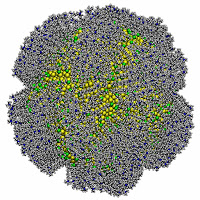I’m happy to report that my student Gene Chong and Cathy Murphy’s student Meng Wu did precisely this parallel study. Gene made simulations of a simpler system, involving nanoparticles covered by lipids called MUTABs. Meng made NMR measurements of nanoparticles covered by a similar but somewhat longer lipids called MTABs. (Note that if you are worried about the term nuclear in NMR, as in nuclear energy, don’t be. We are just looking at the positions of the nuclei, not spitting them apart. It was the concern over this misunderstanding that led to the use of such a device to look at your body in detail to be called MRI instead of NMR!) The happy result was that the two observations agreed. But only together did Meng’s and Gene’s observations show clearly that the lipids didn’t always cover the nanoparticle smoothly like melted chocolate on ice cream, but rather assembled like sprinkles all pointing out in the same direction packed together in different islands on the surface. This structure means that lipid-decorated nanoparticles will have shape and response to other systems that you might not otherwise anticipate. And this opens the question to our next set of investigations as we chart a course to understand the interactions between nanoparticles and biological components such as membranes.
If you want more detail, check out our article in JACS, just recently published! That is, JACS 141, 4316 (2019), and I'm happy to report that it was funded by the NSF CCI program for our Center for Sustainable Nanotechnology.

No comments:
Post a Comment